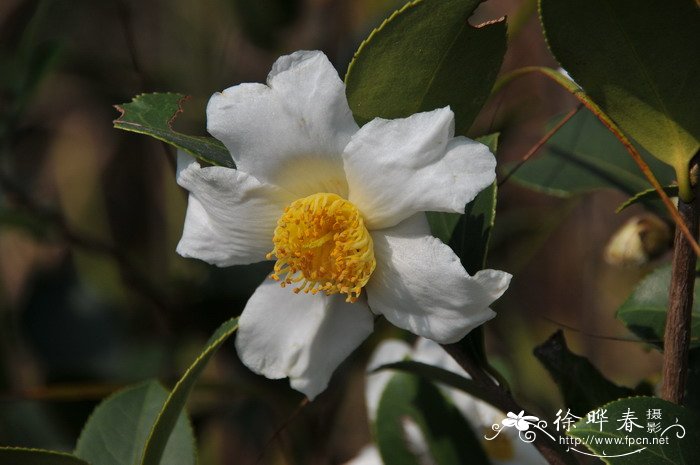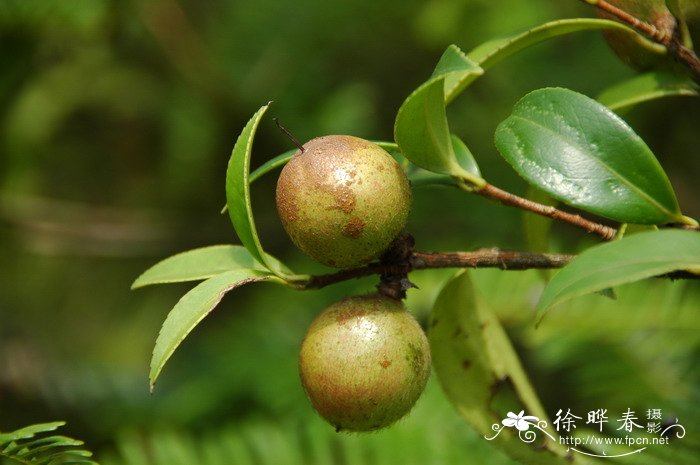油茶Camellia oleifera
中文名(Chinese Name):油茶
学名(Scientific Name):Camellia oleifera Abel
英文名(English Common Name):
别名(Chinese Common Name):
异名(Synonym):Camellia oleifera var. monosperma H. T. Chang Thea biflora Hayata Thea podogyna H. Lév. Thea oleifera (Abel) Rehder et E. H. Wilson Camellia meiocarpa Hu Thea sasanqua var. loureiri Pierre Camellia drupifera f. biflora (Hayata) S.S.Ying Camellia banksiana Lindl. ex Champ. Camellia obscura Nakai Camellia podogyna (H.Lév.) Melch. Theopsis banksiana (Lindl.) Nakai Thea sasanqua var. loureiroi Pierre
科属(Family & Genus):山茶科(Theaceae)山茶属
形态特征(Description):灌木或中乔木;嫩枝有粗毛。叶革质,椭圆形,长圆形或倒卵形,先端尖而有钝头,有时渐尖或钝,基部楔形,长5-7厘米,宽2-4厘米,有时较长,上面深绿色,发亮,中脉有粗毛或柔毛,下面浅绿色,无毛或中脉有长毛,侧脉在上面能见,在下面不很明显,边缘有细锯齿,有时具钝齿,叶柄长4-8毫米,有粗毛。花顶生,近于无柄,苞片与萼片约10片,由外向内逐渐增大,阔卵形,长3-12毫米,背面有贴紧柔毛或绢毛,花后脱落,花瓣白色,5-7片,倒卵形,长2.5-3厘米,宽1-2厘米,有时较短或更长,先端凹入或2裂,基部狭窄,近于离生,背面有丝毛,至少在最外侧的有丝毛;雄蕊长1-1.5厘米,外侧雄蕊仅基部略连生,偶有花丝管长达7毫米的,无毛,花药黄色,背部着生;子房有黄长毛,3-5室,花柱长约1厘米,无毛,先端不同程度3裂。蒴果球形或卵圆形,直径2-4厘米,3室或1室,3爿或2爿裂开,每室有种子1粒或2粒,果爿厚3-5毫米,木质,中轴粗厚;苞片及萼片脱落后留下的果柄长3-5毫米,粗大,有环状短节。花期冬春间。
分布(Distribution):从长江流域到华南各地广泛栽培,是主要木本油料作物。海南800米以上的原生森林有野生种。
引自中国植物志英文版:FOC Vol. 12 Page 367, 409, 411
Camellia oleifera C. Abel, Narr. Journey China. 174. 1818.
油茶 you cha | Theaceae | Camellia
Camellia oleifera var. monosperma Hung T. Chang; C. drupifera Loureiro f. biflora (Hayata) S. S. Ying; Thea biflora Hayata; T. oleifera (C. Abel) Rehder & E. H. Wilson; T. podogyna H. Léveillé; T. sasanqua (Thunberg) Cels var. loureiroi Pierre.
Shrubs or trees, 1-5(-8) m tall. Young branches grayish brown; current year branchlets reddish brown, pubescent. Petiole 5-10 mm, pubescent; leaf blade elliptic, oblong-elliptic, or obovate, 3-10(-12) × 2-4(-5) cm, leathery to rigidly leathery, abaxially pale green, sparsely pilose along midvein or glabrous, and becoming yellowish green when dry, adaxially dark green, shiny, and hirtellous along midvein, midvein raised on both surfaces, secondary veins 5-8 on each side of midvein, abaxially obscure, and adaxially raised, base broadly cuneate to cuneate, margin serrate to serrulate, apex acute to acuminate and with an obtuse tip. Flowers axillary or subterminal, solitary or paired, 4-6 cm in diam., subsessile. Bracteoles and sepals 8-11, caducous; outer bracteoles and sepals lunate to semiorbicular, scalelike, 1-3 mm, glabrous or subglabrous; inner bracteoles and sepals obovate to suborbicular, 0.9-1.2 cm, outside yellow tomentose, inside glabrous, margin membranous and ciliolate. Petals 5-7, white, nearly distinct, obovate, oblong-obovate, or oblanceolate, 2.5-3.5(-4.5) × 1.5-2.5(-3) cm, apically 2-parted. Stamens ca. 1.5 cm, glabrous; outer filament whorl basally connate for ca. 5 mm. Ovary globose, 2-3 mm in diam., white tomentose, 3-loculed; style 0.8-1.2 cm, glabrous or base tomentose, apically 3-lobed to 3-parted. Capsule globose to ellipsoid, 2-4 cm in diam., 1-3-loculed with 1 or 2 seeds per locule; pericarp 3-6 mm thick, villous, splitting into 2 or 3 valves. Seeds brown to reddish brown, globose to semiglobose, 1.5-2 cm in diam. Fl. Dec-Jan, fr. Sep-Oct. 2n = 30, 45, 60, 90.
Forests, thickets; (200-)500-1800 m. Anhui, Fujian, Guangdong, Guangxi, Guizhou, Hainan, Henan, Hubei, Hunan, Jiangsu, Jiangxi, S Shaanxi, Sichuan, Yunnan, Zhejiang [N Laos, N Myanmar, N Vietnam].
This species is extensively cultivated as an oil seed. Because of its long cultivation in China, it is often difficult to know if particular collections are wild, cultivated, or escaped. For this reason the original wild distribution is uncertain although it is possibly in the region of S Qin Ling to the Huai He valley. Camellia oleifera is the hardiest species in the genus and has the farthest north distribution.



(责任编辑:徐晔春)
学名(Scientific Name):Camellia oleifera Abel
英文名(English Common Name):
别名(Chinese Common Name):
异名(Synonym):Camellia oleifera var. monosperma H. T. Chang Thea biflora Hayata Thea podogyna H. Lév. Thea oleifera (Abel) Rehder et E. H. Wilson Camellia meiocarpa Hu Thea sasanqua var. loureiri Pierre Camellia drupifera f. biflora (Hayata) S.S.Ying Camellia banksiana Lindl. ex Champ. Camellia obscura Nakai Camellia podogyna (H.Lév.) Melch. Theopsis banksiana (Lindl.) Nakai Thea sasanqua var. loureiroi Pierre
科属(Family & Genus):山茶科(Theaceae)山茶属
形态特征(Description):灌木或中乔木;嫩枝有粗毛。叶革质,椭圆形,长圆形或倒卵形,先端尖而有钝头,有时渐尖或钝,基部楔形,长5-7厘米,宽2-4厘米,有时较长,上面深绿色,发亮,中脉有粗毛或柔毛,下面浅绿色,无毛或中脉有长毛,侧脉在上面能见,在下面不很明显,边缘有细锯齿,有时具钝齿,叶柄长4-8毫米,有粗毛。花顶生,近于无柄,苞片与萼片约10片,由外向内逐渐增大,阔卵形,长3-12毫米,背面有贴紧柔毛或绢毛,花后脱落,花瓣白色,5-7片,倒卵形,长2.5-3厘米,宽1-2厘米,有时较短或更长,先端凹入或2裂,基部狭窄,近于离生,背面有丝毛,至少在最外侧的有丝毛;雄蕊长1-1.5厘米,外侧雄蕊仅基部略连生,偶有花丝管长达7毫米的,无毛,花药黄色,背部着生;子房有黄长毛,3-5室,花柱长约1厘米,无毛,先端不同程度3裂。蒴果球形或卵圆形,直径2-4厘米,3室或1室,3爿或2爿裂开,每室有种子1粒或2粒,果爿厚3-5毫米,木质,中轴粗厚;苞片及萼片脱落后留下的果柄长3-5毫米,粗大,有环状短节。花期冬春间。
分布(Distribution):从长江流域到华南各地广泛栽培,是主要木本油料作物。海南800米以上的原生森林有野生种。
引自中国植物志英文版:FOC Vol. 12 Page 367, 409, 411
Camellia oleifera C. Abel, Narr. Journey China. 174. 1818.
油茶 you cha | Theaceae | Camellia
Camellia oleifera var. monosperma Hung T. Chang; C. drupifera Loureiro f. biflora (Hayata) S. S. Ying; Thea biflora Hayata; T. oleifera (C. Abel) Rehder & E. H. Wilson; T. podogyna H. Léveillé; T. sasanqua (Thunberg) Cels var. loureiroi Pierre.
Shrubs or trees, 1-5(-8) m tall. Young branches grayish brown; current year branchlets reddish brown, pubescent. Petiole 5-10 mm, pubescent; leaf blade elliptic, oblong-elliptic, or obovate, 3-10(-12) × 2-4(-5) cm, leathery to rigidly leathery, abaxially pale green, sparsely pilose along midvein or glabrous, and becoming yellowish green when dry, adaxially dark green, shiny, and hirtellous along midvein, midvein raised on both surfaces, secondary veins 5-8 on each side of midvein, abaxially obscure, and adaxially raised, base broadly cuneate to cuneate, margin serrate to serrulate, apex acute to acuminate and with an obtuse tip. Flowers axillary or subterminal, solitary or paired, 4-6 cm in diam., subsessile. Bracteoles and sepals 8-11, caducous; outer bracteoles and sepals lunate to semiorbicular, scalelike, 1-3 mm, glabrous or subglabrous; inner bracteoles and sepals obovate to suborbicular, 0.9-1.2 cm, outside yellow tomentose, inside glabrous, margin membranous and ciliolate. Petals 5-7, white, nearly distinct, obovate, oblong-obovate, or oblanceolate, 2.5-3.5(-4.5) × 1.5-2.5(-3) cm, apically 2-parted. Stamens ca. 1.5 cm, glabrous; outer filament whorl basally connate for ca. 5 mm. Ovary globose, 2-3 mm in diam., white tomentose, 3-loculed; style 0.8-1.2 cm, glabrous or base tomentose, apically 3-lobed to 3-parted. Capsule globose to ellipsoid, 2-4 cm in diam., 1-3-loculed with 1 or 2 seeds per locule; pericarp 3-6 mm thick, villous, splitting into 2 or 3 valves. Seeds brown to reddish brown, globose to semiglobose, 1.5-2 cm in diam. Fl. Dec-Jan, fr. Sep-Oct. 2n = 30, 45, 60, 90.
Forests, thickets; (200-)500-1800 m. Anhui, Fujian, Guangdong, Guangxi, Guizhou, Hainan, Henan, Hubei, Hunan, Jiangsu, Jiangxi, S Shaanxi, Sichuan, Yunnan, Zhejiang [N Laos, N Myanmar, N Vietnam].
This species is extensively cultivated as an oil seed. Because of its long cultivation in China, it is often difficult to know if particular collections are wild, cultivated, or escaped. For this reason the original wild distribution is uncertain although it is possibly in the region of S Qin Ling to the Huai He valley. Camellia oleifera is the hardiest species in the genus and has the farthest north distribution.
(责任编辑:徐晔春)
踩一下[0]

顶一下[3]